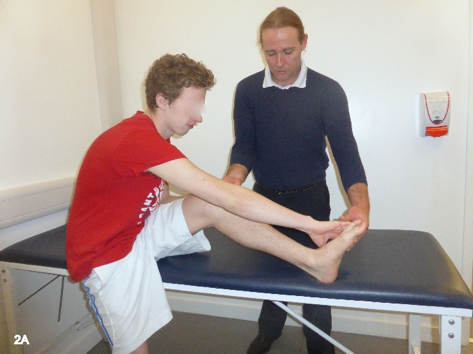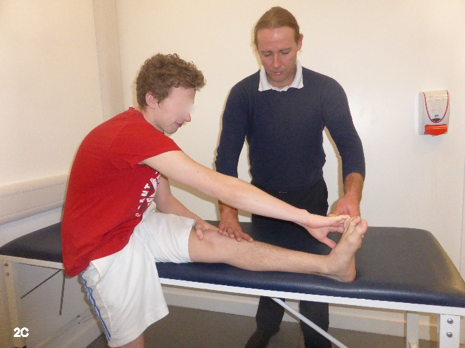Max Pietrzak was the author of a paper that led to the most popular NOIjam post of 2016. Max is back and in his own words talking about his latest research and paper.
Modified long sit slump (MLSS), that almost sounds familiar?
A ‘new’ neurodynamic tension technique, the MLSS (see photographs below), was recently demonstrated to have a seemingly powerful effect on hamstring extensibility and stretch tolerance, and it certainly shares many attributes with its neurodynamic mates, Slump and Long Sit Slump, but with a twist! That is, the MLSS is postulated to facilitate maximal sciatic-tibial nerve strain and tension while minimising lower lumbar spinal flexion stress through counter-rotation of the ilia.


I was first introduced to the MLSS by a big Australian physio named Nev Austin, circa 1999, although the technique didn’t have a catchy name back then! But what it lacked in formality and subtlety, it surely seemed to make up for in effect. After a few more years of practice I realised there weren’t many (if any?) other physios utilising the technique, nor was it specifically described in the neurodynamics literature. This eventually provided me some impetus to undertake post-graduate study, and recently led to my MSc dissertation being published in Journal of Sport Rehabilitation (full paper available at link) alongside Dr Niels Vollaard, project supervisor par excellence.
Magic you say?
As clinicians we all know that feeling when a client says ‘you have magic fingers!’, but after a while you learn not to get too excited, particularly on a Friday afternoon. What I soon noticed after starting to utilise the MLSS, is that it seemed to produce the ‘magic therapy’ response, that is, rapid, marked and lasting clinical improvement in pain and rage of motion, on a regular basis and for a variety of clinical presentations. This fortuitously coincided with my introduction and very liberal interpretation of Michael Shacklock’s ‘covertly altered neurodynamic state’ concept, and I was soon regularly performing ‘clinical magic’ on anything and everything that presented, from the mid thorax down!
Jokes aside, the paper by Pietrzak & Vollaard1 provides level 2C evidence demonstrating than a mere 3 sets, 5repetitions held for 5 seconds of unilateral MLSS application significantly improved bilateral segmental (hamstring; ipsilateral > contralateral) and extra-segmental (rectus-femoris; ipsilateral = contralateral) muscle extensibility and stretch tolerance, which was retained 3 weeks post-intervention. To the author’s knowledge, this is the first stretching study to demonstrate lasting contralateral and/or extra-segmental effect from unilateral intervention. Further, by demonstrating relatively decreased total stretch time required compared to previous research, the findings may have implications for stretching and clinical practices by decreasing total stretch time and thus improving efficiency through utilisation of neurodynamic tension.
Terror, is it inevitable?
As PT’s, we are commonly referred to as ‘physio- terrorists,’ but over the years It dawned on me that I rarely heard this directly to my face….. I’m sure it’s just clients being polite! Reflecting on almost 20 years clinical practice, I do feel that one of my most noticeable improvements as a therapist has been a gradual lessening in frequency of minor adverse responses to intervention. Perhaps part of this was tempering a tendency to over-utilise more ‘aggressive’ techniques aimed predominantly at the ‘tissues,’ which were perceived to possess a high ‘magic factor’, and transitioning to a much more balanced, biopsychosocial approach. Given the highly significant and interesting findings of the current study, it is poignant to re-iterate that the MLSS facilitates, in all probability, maximally tolerated sciatic-tibial nerve strain and tension, thus should be utilised judiciously and by those with the appropriate training. This will serve to minimise the ‘physio-terror’ label!
Between two worlds?
The scientific understanding of muscle stretching has recently shifted towards what is termed the ‘Sensory Theory’ (Weppler & Magnusson, 2010).2 The evidence suggests that for stretching protocols of eight weeks duration or less, increases in muscle flexibility result predominantly from changes in subject’s tolerance of stretch rather than lasting structural change in the muscle architecture. Based on the sensory theory, the sharp ‘neural’ stretch sensation we normally feel with application of a neurodynamic tension technique, in this case MLSS, was hypothesised to potentially have a significant effect on hamstring extensibility and stretch tolerance. We further hypothesised that increased stretch tolerance, probably through mechanosensitive nociceptor desensitisation, may demonstrate contralateral and extra-segmental effects, similar to what is considered to occur with nociceptive sensitisation models (see full text for detailed discussion of potential neurophysiological mechanisms). Based on this rationale and clinical experience, the contralateral and segmental MLSS induced effects were not entirely surprising. However, the fact that the all significant post-intervention effects were maintained three weeks post intervention was unexpected.
Something in between magic and terror?
So… is it magic, terror or something in-between? It probably depends on who you ask and in what context! From a research and clinical perspective, the study has several limitations. Primarily, the cross-over counterbalanced design without assessor blinding necessitates follow up in a single blinded randomised controlled trial for to verify the findings. Further, the study sample was of young healthy subjects with clinically tight hamstrings, therefore further investigations in older subjects or those with a past history of hamstring injury is indicated. However, the study does provide rationale and preliminary supporting evidence that single session unilateral MLSS intervention can be safely and efficaciously applied by an experienced physiotherapist to improve bilateral segmental and extra-segmental hamstring extensibility and stretch tolerance in young, healthy subjects with clinically tight hamstrings, with the effects being retained for up to three weeks. If future studies substantiate the results, this may have implications for both general stretching and clinical practices by improving stretching efficiency through utilisation of neurodynamic tension, which perhaps already occurring with techniques such as yoga.
-Max Pietrzak
- Pietrzak M, Vollaard NBJ. Effects of a novel neurodynamic tension technique on muscle extensibility and stretch tolerance: A cross-over counterbalanced study. J Sport Rehabil.2016; Ahead of print.
- Weppler C, Magnusson S. Increasing muscle extensibility: A matter of increasing length or modifying sensation. Phys Ther. 2010; 90: 438-449.

Hi Max,
I think the world does not know what to do about this finding and especially the effect at 3 weeks. Maybe your group did not have clinically tight hamstrings after all?
My suggestion is that the technique may offer a novel access to neural tissues and processes such as a sliding workout of the myelin lamellae, opening the bands of Fontana, novel intraneural fluid pressure changes, bit of an axoplasm flush, blood pushed to a few dry bits, cord and brain representations aware there is more to life than existing movements and limitations, a bit of CSF nourishment to the roots,a good crutch stretch etc etc etc and ultimately the brain “thinks” ‘crikey, my bits haven’t been there before, that was good, its safe to be nice and loose…….’
Terribly scientific I know!
David
Very nice marvelous.
Clinically, it reminds me of the technique of Mulligan Bent Leg Raise where the same kind of mechanisms must happen. For a lot of techniques actually …